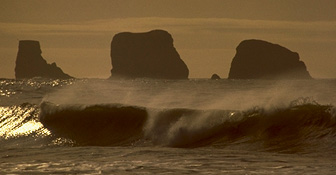El Nino is Brewing Again
News story originally written on September 19, 1997
They've arranged for emergency evacuation. They've sealed off their garage, lining the walls of their house with sandbags. They even threw a "preparedness party" for the neighborhood. The O'Tooles of Southern California are expecting disaster. Why? El Nino.El Nino is an anomoly in the ocean-atmosphere system in the tropical Pacific that has global consequences. When there are El Nino conditions in the Pacific, one can expect global weather changes including increased rainfall in the Southern U.S. and in parts of South America.
This phenomenon is thought to occur every 2-7 years. It was first named El Nino (the Spanish term for a boy child) because the condition first appeared off the coast of South America around Christmas time when the birth of the boy child Jesus is celebrated.
Two independent Earth-orbiting satellites have just provided convincing evidence that this weather-disrupting phenomenon, El Nino is back and strong. In fact, NOAA (the National Oceanic, Atmospheric Administration) has issued advisories because of these recent satellite findings.
Many scientists and civilians are concerned with these advisories because of what the "El Nino of the Century" brought in 1982-1983. Erin O'Toole said, "People around here are nervous." This previous El Nino brought increased rainfall to the Southern U.S. and certain countries in South America causing destructive flooding estimated to have cost these countries billions of dollars. To Australia, Africa, and Indonesia it brought severe drought, which caused devastating brush fires. Hopefully, satellites like JPL's TOPEX/POSEIDON and NASA's UARS will help prevent some of this destruction by providing scientists with accurate data concerning El Nino conditions.















